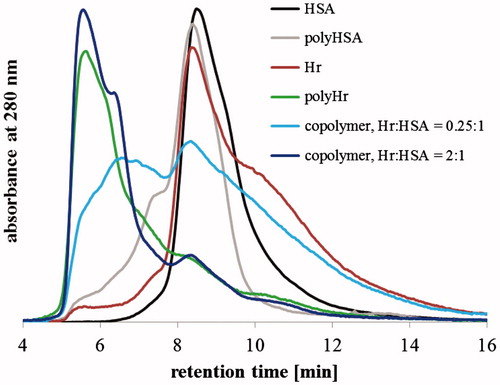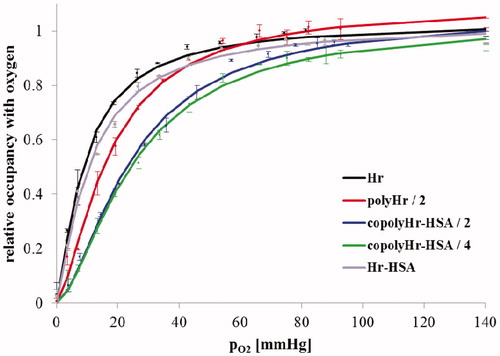Figures & data
Figure 1. The three-dimensional structure of the P. gouldii Hr (PDB ID: 1I4Y) and HSA (PDB ID: 1GNJ); lysine residues are colored in green; the two layers of four subunits of Hr octamer are colored in red and pink, respectively; di-iron centers are represented as blue spheres.
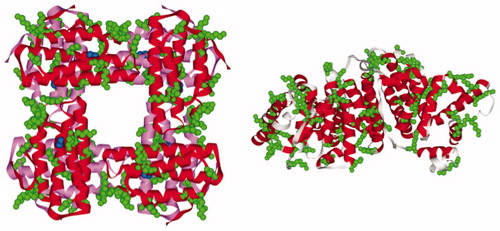
Figure 2. 15% SDS-PAGE gel of the reaction mixtures of copolyHr-HSA (lanes a) and of polyHr + polyHSA (lanes b) at 0.15 mM Hr, 8 mM GL, and varying HSA concentrations (listed in ).
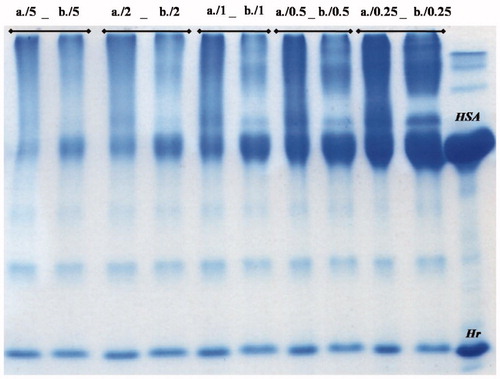
Table 1 . Protein and lysine residue concentrations in the GL-polymerization reaction mixtures subjected to the 15% SDS-PAGE as shown in Figure 1. Hr concentration was kept constant at 150 μM (monomer basis) in all reaction mixtures.
Figure 4. 15% SDS-PAGE of GL-copolymerized Hr-HSA (lanes a) and mixtures of separately GL-polymerized Hr and HSA (lanes b); reaction conditions: 0.15 mM Hr, [Hr]Lys: [HSA]Lys = 2:1 (∼14 μM HSA), GL concentrations varying from 2 to 10 mM as indicated by the number in the labels above the lanes.
![Figure 4. 15% SDS-PAGE of GL-copolymerized Hr-HSA (lanes a) and mixtures of separately GL-polymerized Hr and HSA (lanes b); reaction conditions: 0.15 mM Hr, [Hr]Lys: [HSA]Lys = 2:1 (∼14 μM HSA), GL concentrations varying from 2 to 10 mM as indicated by the number in the labels above the lanes.](/cms/asset/adc9dd67-c8d7-4956-94c7-da360896717a/ianb_a_1269118_f0004_c.jpg)
Figure 5. Gel filtration chromatograms of Hr-HSA copolymers; reaction conditions: 0.15 mM Hr, [Hr]Lys:[HSA]Lys = 2:1 (∼14 μM HSA), GL in concentrations varying from 2 to 10 mM.
![Figure 5. Gel filtration chromatograms of Hr-HSA copolymers; reaction conditions: 0.15 mM Hr, [Hr]Lys:[HSA]Lys = 2:1 (∼14 μM HSA), GL in concentrations varying from 2 to 10 mM.](/cms/asset/033f3828-479b-470f-83a2-4f5bf6790bdb/ianb_a_1269118_f0005_c.jpg)
Figure 6. UV–vis absorption spectra of Hr-HSA (co)polymerization mixtures; reaction conditions: 0.15 mM Hr, [Hr]Lys:[HSA]Lys = 2:1 (∼14 μM HSA), GL in concentrations varying from 2 to 10 mM (note: neither HSA nor polyHSA absorb in the visible region of the spectrum).
![Figure 6. UV–vis absorption spectra of Hr-HSA (co)polymerization mixtures; reaction conditions: 0.15 mM Hr, [Hr]Lys:[HSA]Lys = 2:1 (∼14 μM HSA), GL in concentrations varying from 2 to 10 mM (note: neither HSA nor polyHSA absorb in the visible region of the spectrum).](/cms/asset/6dab540a-01fe-435f-ad8b-c7031379fc6b/ianb_a_1269118_f0006_c.jpg)
Figure 7. Anion-exchange (left panel) and gel filtration size exclusion (right panel) chromatograms of GL-polymerized Hr and GL-co-polymerized Hr-HSA; reaction conditions: 0.15 mM Hr, [Hr]Lys: [HSA]Lys = 2:1 (∼14 μM HSA), GL concentrations varying from 2 to 6 mM. A, B, and C labels in the left panel correspond to fractions A, B, and C in the right panel.
![Figure 7. Anion-exchange (left panel) and gel filtration size exclusion (right panel) chromatograms of GL-polymerized Hr and GL-co-polymerized Hr-HSA; reaction conditions: 0.15 mM Hr, [Hr]Lys: [HSA]Lys = 2:1 (∼14 μM HSA), GL concentrations varying from 2 to 6 mM. A, B, and C labels in the left panel correspond to fractions A, B, and C in the right panel.](/cms/asset/fe6fa19e-b75e-46b4-b821-e5dcf10ea56b/ianb_a_1269118_f0007_c.jpg)
Figure 8. UV–vis absorption spectra of the oxy forms of Hr, GL-polymerized Hr, and co-polymerized Hr-HSA.
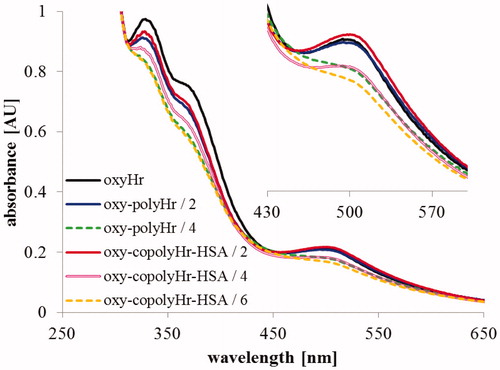
Table 2. Estimated values of dioxygen affinity (P50) and half-life of auto-oxidation (t1/2) of unmodified and GL-derivatized Hrs and Hr-HSA GL-copolymers; reaction conditions: 0.15 mM Hr, [Hr]Lys:[HSA]Lys = 2:1 (∼14 μM HSA), GL in concentrations as indicated (2 or 4 mM).

